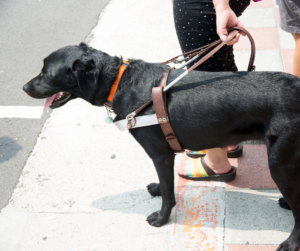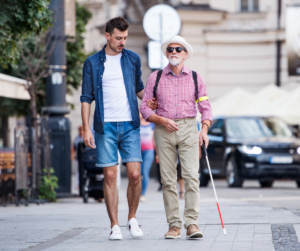Guide Dogs Vs. White Canes: The Comprehensive Comparison
A person who is blind or visually impaired has many choices for assistive support to help guide them in their search for independence. Chief among them is the white cane and a guide dog. There are pros and cons to each choice a person must weigh before investing time in learning to use or work with their choice, and often require a monetary investment. In honor of National Guide Dog Month in September and White Cane Awareness Day (October 15, 2020), we’re breaking down the things to consider for each option.
One of the biggest and most obvious differences between a guide dog and white cane is that a guide dog is trained to avoid obstacles along their pathway. A white cane helps locate impediments so that the blind person can decide how best to maneuver around them. Many guide dog users pass by people, animals, garbage cans, storefront sidewalk signs, and benches without knowing they are there. In contrast, a cane user might accidentally trip over the aforementioned bench or storefront sidewalk sign because their cane didn’t quite detect it.
The decision to train with a guide dog can be truly life-changing. It takes good mobility skills, a lot of hard work, time commitment, patience, and the ability to completely trust your guide dog. A guide dog and their handler have a symbiotic relationship: the two work together to form the perfect team. The magic doesn’t happen overnight; on average, it takes roughly 6 months for the team to work together smoothly and form an inseparable bond.
 Some advantages of guide dog travel are:
Some advantages of guide dog travel are:
- Guide dogs are living beings, so they provide companionship, love, comfort, and respect while keeping their handlers safe.
- A guide dog is allowed to travel with their handler anywhere the general public is allowed. This includes hospitals, doctor’s offices, hotels, parks, gyms, stores, shopping malls, restaurants, Uber/Lyft, taxis, buses, trains, and airports.
- People generally love to talk about dogs, so their handlers tend to meet, interact, and socialize with more people.
- Working with a dog is usually more smooth and graceful. Guide dogs are trained to weave their handlers in and out of crowds.
- You are never walking alone, which sometimes helps owners feel more secure in new and unfamiliar areas.
Some disadvantages of guide dog travel are:
- Guide dogs generally only work for 6-8 years. Even though you don’t want them to age, they still do.
- Handlers need to work diligently to maintain their dog’s training. This includes working the dog every day; and reinforcing obedience, rules and good behaviors.
- Even though the dogs are well trained, they are still dogs and will occasionally do something naughty.
- Dogs get sick, and their veterinary expenses are not cheap.
- Other expenses include high-quality dog food, durable dog toys, grooming supplies, and extra working gear (like a raincoat and protective boots, for some).
- Maintaining a daily schedule for feeding, watering, relieving, play, and grooming is essential but can be difficult.
- Handlers will need to plan ahead for late evenings, overnight trips, and vacations.
- There are some places that handlers may decide not to take their guide dog. This can include movie theaters with sticky floors, loud concerts, amusement parks, and certain foreign countries that do not have disability access laws.
 On the other hand, most people who are blind or visually impaired utilize a white cane to maneuver daily. Some advantages of white cane use is:
On the other hand, most people who are blind or visually impaired utilize a white cane to maneuver daily. Some advantages of white cane use is:
- Canes are relatively easy to replace and are cost-efficient. They cost roughly $40, are durable and should last for several years.
- People will not stop midway through a busy street crossing to ask a white cane user to pet their cane.
- Canes do not shed; no need to completely avoid wearing black pants for the rest of your life.
- Canes are easy to manage and do not require daily care and maintenance. Just grab it and go.
Some disadvantages of cane travel are:
- They love to get stuck in cracks along the sidewalk – leading to possible stomach jabbing!
- Cane travel can be more challenging and not as fluid since the user is constantly getting tactile feedback from their environment.
- White canes tend to create unspoken barriers between sighted people and blind people. Sometimes, cane users may feel ignored or overwhelmed by individuals who believe they cannot get around safely.
- A cane cannot detect a speeding car or a silent vehicle when crossing an intersection as a guide dog can deem it unsafe to cross.
- Sometimes wear and tear on a white cane can lead to unsafe issues. If a cane breaks while the user is out and about, it could leave the person with no way of safely navigating home.
Clovernook Center employee Deanna Lewis and her guide dog Mambo are strong advocates for good orientation and mobility skills, regardless of which mobility tool a person chooses to use.
“I primarily use my guide dog, but I am confident in my cane skills as well,” said Deanna. “I think it’s important to keep these skills up just in case something was to happen to my guide dog, and I wouldn’t be able to use him or train with a new dog for a long time. Having a guide dog has significantly improved my independence and self-confidence.”
Whether you chose a white cane or a guide dog, it’s important to feel comfortable with whichever method you choose. As Deanna often says, “Travelling with a cane will get you places, but having a guide dog makes the journey fun!”
Stay tuned this month as Clovernook Center celebrates National Guide Dog Month way to raise awareness, appreciation, and support for guide dogs in our community.
